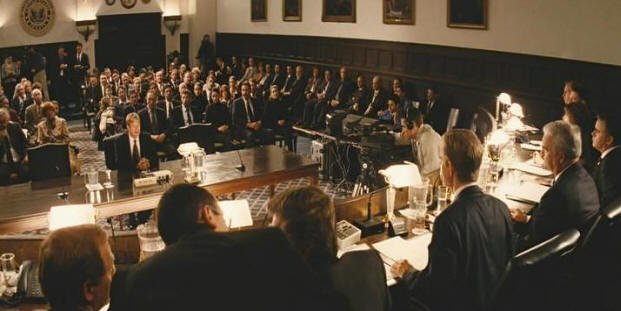Two Myths and One Truth About Congressional Testimony
This post by Chad English, the director of science policy outreach for the organization COMPASS, originally appeared at COMPASSBlogs.org and is reprinted with their permission.
 You’ve just hung up the phone after a call with a U.S. congressional staffer. After a wide-ranging conversation and some probing questions, the staffer invited you to be a witness at a congressional hearing. You’ve even got the official letter signed by the chair of the committee.
You’ve just hung up the phone after a call with a U.S. congressional staffer. After a wide-ranging conversation and some probing questions, the staffer invited you to be a witness at a congressional hearing. You’ve even got the official letter signed by the chair of the committee.
Now what?
If you haven’t been involved in a congressional hearing before, it may not be obvious what’s expected of you. Luckily, there are a lot of resources out there, some of them specifically aimed at scientists. The University Corporation for Atmospheric Research (UCAR) has a nice simple one. The American College of Emergency Physicians covers the entire process – including follow-up – in great depth. And for a truly comprehensive look try the U.S. Army’s guide. It isn’t aimed at scientists, but it has great detail about the process. There are also comprehensive books and courses.
Some of the advice is not too hard to guess:
- Understand why this hearing is happening andwhy you were invited to testify;
- Keep your opening statement short and clear for a non-technical audience;
- Understand who is in the room and make your comments relevant to their constituents;
- Ask for help to prepare – your government affairs office and the congressional staff who invited you both want you to shine, so take advantage of their insight and guidance.
But some elements of congressional hearing “culture” aren’t so obvious if you’ve not encountered them before:
- You’ll be expected to pay your own way
- The timeline may be insanely short
- You will be expected to make concrete recommendations for what Congress can do (which as a scientist you may find uncomfortable).
As you scramble to put together your testimony in the midst of making travel arrangements, getting your suit cleaned, finding your lucky tie, and, of course, your day job, it’s easy to get caught up in the perceived glamour of the hearing process. But if you focus on the big picture you can turn this opportunity into something much bigger. To that end, here are two common myths and an under-appreciated truth that can help you maximize the impact of your time in our nation’s capital.
MYTH: Members of Congress and their aides will be hanging on your every word.
A congressional hearing is a Big Deal, right? The evening news reports on them (remember the baseball and steroids hearings?). You’ll be on center stage on Capitol Hill. You’ll have the attention of a couple of dozen lawmakers (and their staff). You’ll give your five minutes of opening remarks, then they’ll ask you questions, and the members and their aides will hang on your every word. Right?
REALITY: Your audience might be really small, and you might not even get their attention.
For the overwhelming majority of hearings you’ll be lucky to get six members of Congress or three senators in the room at a time. As I write, there are 11 hearings scheduled today just in the Senate. Most members of Congress are double and triple booked at any given time. They simply can’t attend all the hearings.
You will get five minutes to deliver your key message. They might ask you questions. But they also might not. Everyone on the dais already (thinks they) know what you’re going to say. Remember, you submitted your written testimony in advance and they read it, so don’t be surprised if they’re checking their Blackberries or talking to one another while you speak. This can all make it feel like you’re not really having an impact.
So what’s a researcher to do? If you nail your delivery, make your point clearly, and connect it to their constituents in a compelling way, you might shift their attention from their email to you. Boil down your message to three key points or fewer, make it relevant to their constituents, and then don’t just read it. Rehearse enough that you can use talking points instead and you will find your whole demeanor changes. It’s much easier to get their attention when you’re talking to them rather than reading to them. Put it in plain language and make it as personal as you can. Congress is a storytelling culture – they communicate by anecdotes about real people, so give them something they can use.
Finally, don’t underestimate the value of your written testimony. Key staff will read it, some of the members will read it, and it will become an official (and permanent) part of the congressional record. It’s not unusual for staff to refer back to testimony for months or years as they craft and tweak laws, so this can be a real contribution to the Congressional knowledge base.
MYTH: You were invited as a rational, objective voice in the midst of the political brouhaha.
You will provide a disinterested perspective on the topic at hand and help the members of Congress and their staff sort fact from conjecture. Right?
REALITY: You were invited because you serve a political purpose for someone.
This is not necessarily nefarious and it’s certainly not a reason to avoid getting involved. You may have been invited to lay the scientific groundwork for a technical policy issue (think fracking). But ultimately political debates are about values.
So what’s a researcher to do? Navigating the relationship between science and advocacy is not simple. Make sure you’ve thought carefully about your role. You want to be clear what’s expected of you and what you’re comfortable with. Were you invited to share your opinion? Your judgement? Your technical knowledge? And what are you comfortable saying in this context? Youwill be asked the policymakers’ favorite question: “So what should we do”? Be clear about how you want to answer it before you step into the room. And think carefully about your relationship with advocacy and credibility.
TRUTH: You are a Big Deal for a day – this presents a Big Opportunity.
You were invited to testify, ergo somebody inside the Beltway thinks you have something to say that’s worth listening to. And what you have to say is inherently relevant to a particular policy decision that is on many people’s minds (e.g. a bill, oversight of an agency, a budget).
This presents a Big Opportunity, but only part of that is the hearing itself. If you want to engage in federal policy beyond this hearing, you need to understand what’s on the policy horizon and let people know who you are. Use your time in town as an opportunity to grow your network and visibility within the federal policy community. It’s time to start setting up meetings.
How do you do this? Start by asking for help. Get in touch with your government affairs or public relations office. Most universities have one (or both) of these offices, as do many private firms, scientific or technical societies, and NGOs. They can help you target your meetings, and in some cases can help set up the meetings and even accompany you (don’t pass up that offer – they can provide really helpful context and insight to make the most of your conversations). If you’re at a loss, ask the staffer who invited you for advice. Then ask your member of Congress and your two senators for meetings. If you’re testifying for a House committee, set up meetings with their counterparts in the Senate, and vice versa.
Then go into the meetings with a goal that goes beyond sharing perspectives relevant to the hearing (which you’ll want to do also). Get them to tell you what else is happening in your issue area and what are the politics driving the conversation. This is your opportunity to turn the tables and pick their brains. What other decisions are likely on the horizon, and when are they likely to occur? Who’s driving that? Who’s opposing it? Is this all just show, or are there real prospects for action?
If you step back from the glare of the hearing’s proverbial footlights and look at the big picture, you have a great opportunity in front of you. If you take thoughtful advantage of it you are likely to find yourself getting more calls, and maybe asked to come back. That’s the start of sustained engagement – and that’s a path to real impact.






















































































